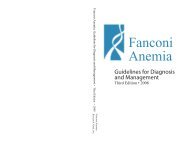FA Family News 3/01 - Fanconi Anemia Research Fund
FA Family News 3/01 - Fanconi Anemia Research Fund
FA Family News 3/01 - Fanconi Anemia Research Fund
You also want an ePaper? Increase the reach of your titles
YUMPU automatically turns print PDFs into web optimized ePapers that Google loves.
Medical Advice From our E-Mail Group<br />
Blanche Alter, MD, on <strong>FA</strong><br />
post-transplant surveillance:<br />
I am a pediatric hematologist/<br />
oncologist at the National Cancer Institute<br />
(NCI), with a long-standing interest<br />
in <strong>FA</strong>. I have recently joined this<br />
e-mail list, and would like to respond<br />
to the question raised by Mr. Jackson<br />
with regard to “what is next” for <strong>FA</strong><br />
patients who have had a successful<br />
bone marrow transplant (BMT). It is<br />
clearly very exciting and gratifying<br />
when BMT succeeds, provides a cure<br />
for aplastic anemia or leukemia, and<br />
eliminates the need for transfusions<br />
and/or androgens. However, it must<br />
be recognized that BMT (or cord stem<br />
cell transplant, or even gene therapy)<br />
is designed to replace or fix only the<br />
bone marrow. The genetic defect in<br />
other body organs is not repaired by<br />
transplant.<br />
Unfortunately, as many of the <strong>FA</strong><br />
families know, one of the long term<br />
concerns after BMT is the possibility<br />
of an increased risk of cancer. In particular,<br />
cancers of the head and neck<br />
have been reported following BMT in<br />
<strong>FA</strong> patients, especially cancers of the<br />
mouth and tongue. The size of the risk<br />
and whether there are excess occurrences<br />
of other specific types of cancers,<br />
over and above what is seen in<br />
the untransplanted <strong>FA</strong> patient, remain<br />
unclear. These important questions<br />
will be the focus of studies that are<br />
now in the planning stage here at the<br />
NCI.<br />
For now, the consensus recommendation<br />
of the group of <strong>FA</strong> experts<br />
convened by the <strong>FA</strong>RF in 1998, with<br />
regard to cancer surveillance, is for<br />
close monitoring of the head and neck<br />
with at least annual dental evaluations<br />
looking for white patches or sores in<br />
the mouth. New symptoms, such as<br />
persistently swollen glands in the neck,<br />
persistent pain in the mouth, tongue or<br />
throat, chronic sores inside the mouth,<br />
or new white patches on the tongue,<br />
gums or cheeks, should be brought to<br />
your caregiver’s attention without waiting<br />
for the next scheduled check-up.<br />
Since little is known about the very<br />
long term outcomes of <strong>FA</strong> patients<br />
who have had a BMT, each patient<br />
should remain under close medical<br />
observation. Specific concerns of<br />
patients and families should be brought<br />
to the attention of their physicians.<br />
John Wagner, MD, on trying to<br />
prevent post-transplant fungal<br />
infections:<br />
In general, we recommend discontinuing<br />
oxymetholone and starting<br />
itraconazole one month prior to BMT.<br />
Although we have not yet proven its<br />
benefit, it is hoped that itraconazole<br />
will reduce the risk of fungal infection<br />
after transplant. This presumes that<br />
the liver function tests are near normal.<br />
While itraconazole may cause liver<br />
problems, this side effect is reversible<br />
by simply stopping the drug. The alternative<br />
is amphotericin, which has a far<br />
greater likelihood of toxicity. Amphotericin<br />
can cause kidney problems,<br />
which would prevent us from using a<br />
full dosage of other crucial drugs.<br />
Therefore, itraconazole is recommended<br />
as a first choice. Amphotericin<br />
would be used if a fungal infection<br />
were suspected or the patient were considered<br />
to be at excessive risk, i.e., colonized<br />
with fungus or a history of fungal<br />
infection.<br />
John Wagner, MD, on clonal<br />
abnormalities:<br />
Monosomy 7 is worrisome. But, in<br />
the absence of any longitudinal study,<br />
its real significance for a given patient<br />
is hard to predict. In contrast to non-<br />
<strong>FA</strong> patients with monosomy 7 where<br />
a bad course is the rule, this may not<br />
be true for <strong>FA</strong> patients. Such cytogenetic<br />
clones may come and go. The<br />
bottom line is that we don’t know the<br />
true significance of monosomy 7.<br />
Nonetheless, closer surveillance is<br />
recommended if a cytogenetic study<br />
reveals a monosomy 7. This means<br />
bone marrow examinations every 4<br />
months for a while to see if the clone<br />
goes away spontaneously, progresses<br />
(i.e., both in terms of proportions of<br />
cells involved and the addition of<br />
other cytogenetic abnormalities), and<br />
alters the way the cells look under the<br />
microscope (i.e., development of myelodysplasia<br />
or leukemia). In my own<br />
experience, I am suspicious that abnormalities<br />
of chromosomes 1 and 3 may<br />
be as frequent and as ominous, but<br />
this, too, is not proven. Any chromosome<br />
abnormality should be viewed as<br />
a call for closer surveillance just as it is<br />
for chromosome 7. ◆<br />
David Williams, MD,<br />
will Join Staff at<br />
Cincinnati Children’s<br />
Hospital<br />
Dr. David Williams, a pioneer in<br />
gene therapy research and well known<br />
to many <strong>FA</strong> families, has announced he<br />
will be moving to the Children’s Hospital<br />
Medical Center in Cincinnati in<br />
the upcoming year. He will be teaming<br />
up with Dr. Richard Harris of the<br />
Blood and Marrow Transplant program<br />
at Cincinnati Children’s Hospital.<br />
Dr. Harris has performed more<br />
than 60 related and unrelated donor<br />
transplants in children with <strong>FA</strong>. ◆<br />
8 <strong>FA</strong> <strong>Family</strong> <strong>News</strong>letter

















